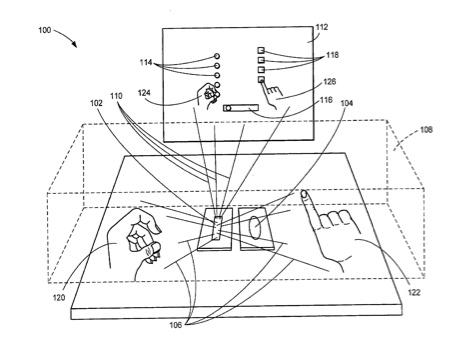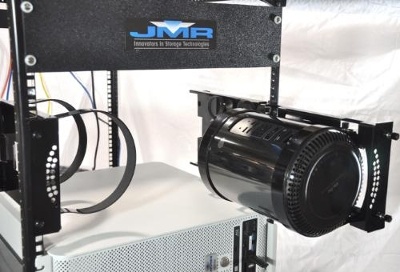A new patent (number 20110298798) at the US Patent & Trademark Office shows that Apple is working on its own Kinect-like technology. Kinect is a motion sensing input device by Microsoft for the Xbox 360 video game console.
Per Apple’s patent a three-dimensional imaging and display system is provided in which user input is optically detected in an imaging volume by measuring the path length of an amplitude modulated scanning beam as a function of the phase shift thereof. Visual image user feedback concerning the detected user input is presented. Christoph H. Krah is the inventor.
The invention provides a three-dimensional imaging and display system. User input is optically detected in an imaging volume by measuring the path length of an amplitude modulated scanning beam as a function of the phase shift thereof. Here’s Apple’s background on the invention:
“Modern three-dimensional (‘3D’) imaging and display technologies are employed in widely diverse environments and technologies. Examples include medical diagnostics, entertainment, flight simulation, robotics, education, animation, biomechanical studies, virtual reality, and so forth. There are numerous 3D input devices including, for example, variations on the computer mouse or touch pad. Ordinarily, these are manipulated in just two dimensions, the x-axis and the y-axis.
“However, through various computer programming artifices, these devices can provide a measure of control in the third dimension of the z-axis. In 3D, however, such constructs can be indirect, time consuming, artificial, and can require considerable practice and training to do well. Similar observations can be made relative to joysticks, which in their original function were designed for input on but two angles (dimensions). Other more sophisticated means of 3D input are therefore preferred.
“One of the preferred methods of 3D input is passive input, wherein a device automatically detects and measures a target in 3D. A common technique for such 3D measurement uses the time of flight (“TOP”) of a scanning light beam. The TOF technique measures the time or duration that lapses or accumulates from the moment of light pulse transmission to the moment of reception of the returning light pulse after reflection by a target object.
“The TOF is directly dependent on the distance the light pulse has traveled. TOF, however, requires very high-speed measuring equipment for accurate distance determination. Measurements at short distances can be inordinately difficult. Equipment costs and complexity are correspondingly high, making TOF unattractive for ordinary consumer applications.
“Another 3D method for measuring distance utilizes light attenuation. Light attenuation is based upon the fact that, in general, the farther a light beam or light pulse travels, the dimmer the reflected light is when it returns. The difficulty with the light attenuation technique, however, is that different objects are more or less reflective, so the measurement is very dependent upon the reflectivity of the target object.
“One way to manage the reflectivity is to standardize it, for example, by attaching standardized target reflectors to the target object. Another method is to modulate the light beam and to compare the reflected signals at different light intensity levels. Both techniques, however, are inconvenient and unnecessarily complicated, as well as costly.
“A need thus remains for uncomplicated, economical, yet highly effective 3D input devices for computers. Such devices need to be able to detect, analyze, and measure objects located in a 3D volume, and to observe and track any motions thereof. The devices should therefore be well suited and designed compatibly for use with 3D graphically intensive activities.
“They need to be capable of operating by optically sensing object or human positions, orientations, and/or motions. For reasons of cost as well as user convenience, they should be compact and capable of incorporation into a simple, small, single housing or unit. They also need to be versatile, and thus capable of working effectively and beneficially with the full range of conventional consumer appliances.
“To be effective, it is also important that such devices be capable, when desired or necessary, of economically but effectively and precisely providing feedback to the user. Thus, such devices should incorporate audio and/or visual mechanisms for reporting to the user the effects and results of the 3D input. And again, for reasons of cost as well as user convenience, such devices should incorporate such user feedback functionality while continuing to be compact and capable of incorporation into a simple, small, single housing or unit.
“Thus, a need still remains for economical, small, portable, and versatile multi-functional 3D imaging and display systems that can both scan and display simultaneously. A need also remains for such devices that provide integral, immediate feedback. A further need remains for such devices that are particularly well adapted for use with other, small electronic devices, particularly hand-held and other portable devices.
“In view of the ever-increasing commercial competitive pressures, appliance sophistication, increasing consumer expectations, and diminishing opportunities for meaningful product differentiation in the marketplace, it is increasingly critical that answers be found to these problems. Moreover, the ever-increasing need to save costs, improve efficiencies, and meet such competitive pressures adds even greater urgency to the critical necessity that answers be found to these problems.
“Solutions to these problems have been long sought but prior developments have not taught or suggested any solutions and, thus, solutions to these problems have long eluded those skilled in the art.”
Perhaps the rumored “iTV” (an Apple-branded HDTV) will sport Kinect-like features as well as Siri technology.
— Dennis Sellers



